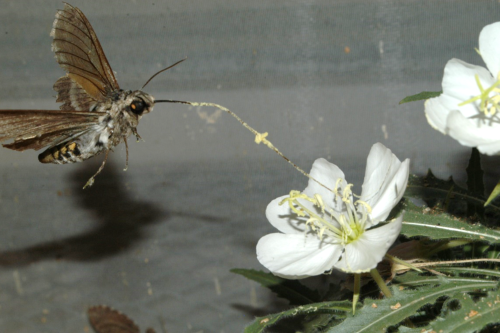Pollen accumulation on hawkmoths varies substantially among moth-pollinated flowers
DOI:
https://doi.org/10.26786/1920-7603(2022)701Keywords:
pollination, pollen placement, pollen loss, pollen fate, hawkmothAbstract
Using the pollen loads carried by floral visitors to infer their floral visitation behavior is a powerful technique to explore the foraging of wild pollinators. Interpreting these pollen records, however, requires assumptions about the underlying pollen dynamics. To compare visitor foraging across flower species, the most important assumption is that pollen is picked up and retained on the visitor at similar rates. Given differences in pollen presentation traits such as grain number or stickiness even among flowers with similar morphologies, however, the generality of this assumption is unclear. We investigated pollen accumulation on the hawkmoth Manduca sexta, testing the degree to which accumulation differed among flower species and how pollen stickiness affected this accumulation. In no-choice floral visitation assays to six plant species visited by long-tongued hawkmoths in the wild, M. sexta individuals were allowed to visit flowers 1, 2, or 5 times, after which the pollen on their proboscises was removed and counted. We found that the six plant species varied orders of magnitude in the number of pollen grains deposited on the moths, with some placing thousands of grains after a single visit and other placing none after five. Plant species with sticky pollen adhesion mechanisms placed more pollen on the moths and had relatively less pollen accumulation over successive visits than non-sticky plants. Intriguingly, moths carried fewer pollen grains after 5 visits than after 2 visits, suggesting that both sticky and non-sticky pollen was lost during foraging. Together, our results suggest that interpretation of pollen load data should be made cautiously, especially when comparing across plant species.

Published
How to Cite
Issue
Section
License
Copyright (c) 2022 Gordon Smith, Robert Raguso, Christine Kim

This work is licensed under a Creative Commons Attribution 4.0 International License.
JPE is an open access journal which means that all content is freely available without charge to the user or his/her institution.
Authors who publish with this journal agree to the following terms:
1) Authors retain copyright and grant the journal right of first publication with the work simultaneously licensed under a Creative Commons Attribution License that allows others to share the work with an acknowledgement of the work's authorship and initial publication in this journal.
2) Authors are able to enter into separate, additional contractual arrangements for the non-exclusive distribution of the journal's published version of the work (e.g., post it to an institutional repository or publish it in a book), with an acknowledgement of its initial publication in this journal.
3) Authors are permitted and encouraged to post their work online (e.g., in institutional repositories or on their website) prior to and during the submission process, as it can lead to productive exchanges, as well as earlier and greater citation of published work (See The Effect of Open Access).
To assure a broader targeted audience, content will be included into databases (such as EBSCO) and directories (such as DOAJ).











